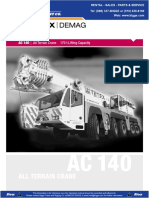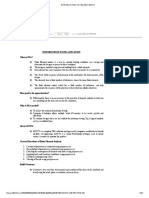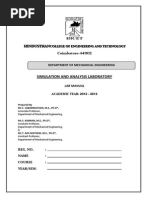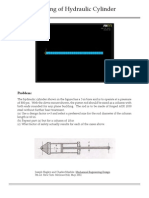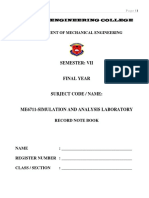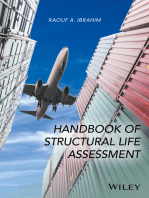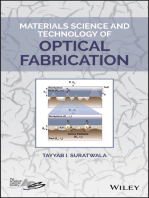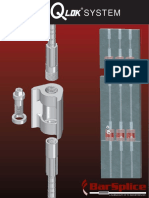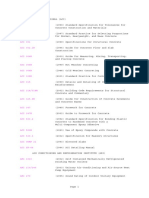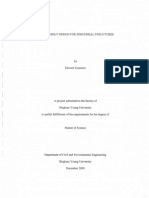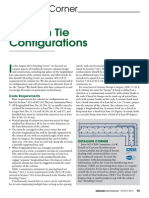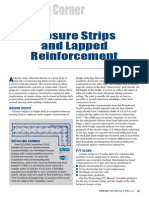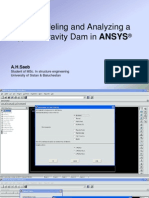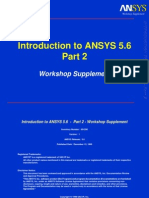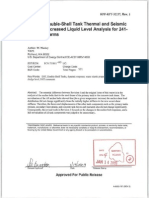Tutorial 6 - Handout
Uploaded by
Nono_geotecTutorial 6 - Handout
Uploaded by
Nono_geotecANSYS - Structural Analysis/FEA Water Tank (Axisymmetric model)
Problem: Analyze a cylindrical water tank with inside diameter 50 meter as shown in the figure below. The tank is made of concrete 30 cm thick (y = 35 MPa). Assume live load on the cover of the tank is 0.7 kN/m2 and the cover dead load is equal to the live load. Stiffness of the soil below the tank is 25000 kN/m. The active and passive pressure coefficients are 0.27 and 0.49, respectively. Soil density is 1842 kg/m3. Neglect the upward pressure from the soil below the tank.
0.15 m D.L. = L.L. = 700 N/m
2
2m
= 1842 kg/m3
Ka = 0.27 Kp = 0.49
3m
50 m
0.3 m
Tutorial 6
1/6
STEP 1: Start up Preference> Structural /UNITS, SI STEP 2: Preprocessor : Define Element Type Preprocessor > Element Type > Add In the pop-up window click Add...> Solid > Quad 8 node 82 (PLANE 82). Click Apply. In the pop-up window click Options.... Keyopt 3 = Axisymmetric
Preprocessor > Element Type > Add In the pop-up window click Add...> Surface Effect > 2D structurl 153 (SURF153). Click Apply. In the pop-up window click Options.... Keyopt 6 = Negative pressure only.
Tutorial 6
2/6
STEP 3: Real Constants and Material Properties Preprocessor > Real Constants > Add/Edit/Delete > Add... Element type for Real Constants Select Type 2 (SURF153) In the next pop-up window, EFS = 25E6 N/m
Preprocessor > Material Models > Structural > Linear > Elastic> Isotropic EX = 30E9 Pa and PRXY = 0.2. To include material self weight in the calculation enter the material density Preprocessor > Material Models > Structural > Density DENS = 2400 kg/m3 STEP 4: Modeling Create keypoints Preprocessor > Modeling > Create > Keypoints > In Active CS Enter the location of each keypoint K, 1, K, 4, 0, 0 25, 0.3 K, 2, 25.3, 0 K, 5, 25.3, 3 K, 3, 0, 0.3 K, 6, 25, 4.85
Tutorial 6
3/6
K, 7, 25.15, 4.85 Create area
K, 8, 25.15, 5
K, 9, 25.3, 5
Preprocessor > Modeling > Create > Areas > Arbitrary > Through KPS Select keypoints (1-2-5-9-8-7-6-4-3-1) to create an area. Mesh area Preprocessor > Meshing > Mesh Tool > Size controls: Lines > Set Click Pick All. Enter Element edge length = 0.15, click OK. Mesh: Areas click Mesh
Apply contact surface to the bottom of the tank From the menu bar Select > Entities... In the pop-up window select Nodes, By location, Y coordinates Enter 0 in the Min, Max box Click OK To see the selected nodes Plot > Nodes Preprocessor > Meshing > Mesh Attributes > Default Attribs Change TYPE to Type 2 (SURF153) Preprocessor > Modeling > Create > Elements > Surf/ Contact > Surf to Surf. Click OK and Pick All in the pop-up window. Now the contact elements are created. Reselect all the nodes by
Tutorial 6 4/6
Select > Entities... > Nodes, By Num/Pick, OK, Pick All To see the full structure of your axisymmetric model PlotCtrls > Style > Symmetry Expansion > 2D-Axisymmetric > Full Expansion Apply load Calculate design load from the tank cover. Total load = (1.5L.L. +1.25D.L.)*Area / perimeter = (1.5*700+1.25*700)*25/2 Distributed load on line 6 = Total load/0.15. Case 1: The tank is empty. There will be an active earth pressure acting outside the tank. Maximum active earth pressure at the bottom = Ka*soil*soil depth = 0.27*1842*9.81*3 Apply triangular pressure to line 2 (be careful of the direction of the line)
Case 2: The tank is full. In this case, the loads are from water pressure, water weight and passive earth pressure. Maximum water pressure at the bottom = water*water depth = 1000*(5-0.3) Apply triangular pressure to line 7. Water weight (/m) = 1000*(5-0.3) - Apply uniform water weight to line 8
Tutorial 6 5/6
Maximum passive earth pressure at the bottom = Kp*soil*soil depth = 0.49*1842*9.81*3 Apply triangular pressure to line 2. STEP 5: Solution STEP 6: Postprocessor Determine the maximum displacements. Check the maximum compressive stress with the allowable stress
a = c y = 0.6 35 10 6 = 21 10 6 Pa
Tutorial 6
6/6
You might also like
- Analysis of Underground Water Tank - SAP 200080% (5)Analysis of Underground Water Tank - SAP 200058 pages
- A Teaching Guide For Structural Steel Connections97% (68)A Teaching Guide For Structural Steel Connections85 pages
- Ansys Manual Final Year Anna UniversityNo ratings yetAnsys Manual Final Year Anna University32 pages
- Computer Aided Engineering CAE KMS 4273 Lab 4No ratings yetComputer Aided Engineering CAE KMS 4273 Lab 410 pages
- Sudharsan Engineering College: Department of Mechanical EngineeringNo ratings yetSudharsan Engineering College: Department of Mechanical Engineering34 pages
- Civil Engineering Design of G Plus Two Floors100% (1)Civil Engineering Design of G Plus Two Floors49 pages
- GTL S08 Ex 03 Elasto Plastic Analysis of Drained FootingNo ratings yetGTL S08 Ex 03 Elasto Plastic Analysis of Drained Footing0 pages
- Steel Building Load Combinations: ApproachNo ratings yetSteel Building Load Combinations: Approach49 pages
- Forced Air Convection On Printed Circuit Board: Workshop 3No ratings yetForced Air Convection On Printed Circuit Board: Workshop 322 pages
- 507 39 Solutions Instructor Manual Chapter 3No ratings yet507 39 Solutions Instructor Manual Chapter 311 pages
- Result: Thus The Maximum Deflection, Tangential and Radial Stress Induced in Long Cylindrical PressureNo ratings yetResult: Thus The Maximum Deflection, Tangential and Radial Stress Induced in Long Cylindrical Pressure25 pages
- Faculty of Applied Engineering and Urban Planning100% (1)Faculty of Applied Engineering and Urban Planning22 pages
- Determining The Drag Force With CFD Method ANSYS Workbench 11.00No ratings yetDetermining The Drag Force With CFD Method ANSYS Workbench 11.0013 pages
- Fara Dimensiuni Transformator 2D 3D NatasaNo ratings yetFara Dimensiuni Transformator 2D 3D Natasa30 pages
- Ejercicios de Ecuaciones Diferenciales, Resueltos en MatlabNo ratings yetEjercicios de Ecuaciones Diferenciales, Resueltos en Matlab6 pages
- Ansys Tutorial Forthe Torque Analysis of The Shaft Attached With Two Disks100% (1)Ansys Tutorial Forthe Torque Analysis of The Shaft Attached With Two Disks13 pages
- EGB424 - Advanced Computational Fluid Dynamics Lab 1 - Laminar Incompressible Flow in A Rectangular 3D Duct Problem DefinitionNo ratings yetEGB424 - Advanced Computational Fluid Dynamics Lab 1 - Laminar Incompressible Flow in A Rectangular 3D Duct Problem Definition20 pages
- Structural Analysis of Five-Storey Building: Location: Old Buswang, Kalibo, AklanNo ratings yetStructural Analysis of Five-Storey Building: Location: Old Buswang, Kalibo, Aklan9 pages
- CES 352 Material Testing: Experiment No. 7No ratings yetCES 352 Material Testing: Experiment No. 710 pages
- Debre Markos University: Finite Element Method (FEM)No ratings yetDebre Markos University: Finite Element Method (FEM)17 pages
- Analytical Modeling of Solute Transport in Groundwater: Using Models to Understand the Effect of Natural Processes on Contaminant Fate and TransportFrom EverandAnalytical Modeling of Solute Transport in Groundwater: Using Models to Understand the Effect of Natural Processes on Contaminant Fate and TransportNo ratings yet
- A First Course in Dimensional Analysis: Simplifying Complex Phenomena Using Physical InsightFrom EverandA First Course in Dimensional Analysis: Simplifying Complex Phenomena Using Physical InsightNo ratings yet
- Energy and Mass Transfers: Balance Sheet Approach and Basic ConceptsFrom EverandEnergy and Mass Transfers: Balance Sheet Approach and Basic ConceptsNo ratings yet
- Plastic Injection Mold Design for Toolmakers - Volume II: Plastic Injection Mold Design for Toolmakers, #2From EverandPlastic Injection Mold Design for Toolmakers - Volume II: Plastic Injection Mold Design for Toolmakers, #2No ratings yet
- Plastic Injection Mold Design for Toolmakers - Volume III: Plastic Injection Mold Design for Toolmakers, #3From EverandPlastic Injection Mold Design for Toolmakers - Volume III: Plastic Injection Mold Design for Toolmakers, #3No ratings yet
- AutoCAD 2015 and AutoCAD LT 2015: No Experience Required: Autodesk Official PressFrom EverandAutoCAD 2015 and AutoCAD LT 2015: No Experience Required: Autodesk Official PressNo ratings yet
- Materials Science and Technology of Optical FabricationFrom EverandMaterials Science and Technology of Optical FabricationNo ratings yet
- Saouma V.E. Matrix Structural Analysis and Introduction To Finite Elements (Lecture Notes, Colorado, S100% (3)Saouma V.E. Matrix Structural Analysis and Introduction To Finite Elements (Lecture Notes, Colorado, S613 pages
- Introduction To ANSYS - Part 2: Workshop SupplementNo ratings yetIntroduction To ANSYS - Part 2: Workshop Supplement1 page
- Verifying Pressures: Workshop 9 Macro BasicsNo ratings yetVerifying Pressures: Workshop 9 Macro Basics8 pages
- Introduction To ANSYS 5.6: Workshop SupplementNo ratings yetIntroduction To ANSYS 5.6: Workshop Supplement4 pages
- Sudharsan Engineering College: Department of Mechanical EngineeringSudharsan Engineering College: Department of Mechanical Engineering
- GTL S08 Ex 03 Elasto Plastic Analysis of Drained FootingGTL S08 Ex 03 Elasto Plastic Analysis of Drained Footing
- Forced Air Convection On Printed Circuit Board: Workshop 3Forced Air Convection On Printed Circuit Board: Workshop 3
- Result: Thus The Maximum Deflection, Tangential and Radial Stress Induced in Long Cylindrical PressureResult: Thus The Maximum Deflection, Tangential and Radial Stress Induced in Long Cylindrical Pressure
- Determining The Drag Force With CFD Method ANSYS Workbench 11.00Determining The Drag Force With CFD Method ANSYS Workbench 11.00
- Ejercicios de Ecuaciones Diferenciales, Resueltos en MatlabEjercicios de Ecuaciones Diferenciales, Resueltos en Matlab
- Ansys Tutorial Forthe Torque Analysis of The Shaft Attached With Two DisksAnsys Tutorial Forthe Torque Analysis of The Shaft Attached With Two Disks
- EGB424 - Advanced Computational Fluid Dynamics Lab 1 - Laminar Incompressible Flow in A Rectangular 3D Duct Problem DefinitionEGB424 - Advanced Computational Fluid Dynamics Lab 1 - Laminar Incompressible Flow in A Rectangular 3D Duct Problem Definition
- Structural Analysis of Five-Storey Building: Location: Old Buswang, Kalibo, AklanStructural Analysis of Five-Storey Building: Location: Old Buswang, Kalibo, Aklan
- Debre Markos University: Finite Element Method (FEM)Debre Markos University: Finite Element Method (FEM)
- Analytical Modeling of Solute Transport in Groundwater: Using Models to Understand the Effect of Natural Processes on Contaminant Fate and TransportFrom EverandAnalytical Modeling of Solute Transport in Groundwater: Using Models to Understand the Effect of Natural Processes on Contaminant Fate and Transport
- A First Course in Dimensional Analysis: Simplifying Complex Phenomena Using Physical InsightFrom EverandA First Course in Dimensional Analysis: Simplifying Complex Phenomena Using Physical Insight
- Energy and Mass Transfers: Balance Sheet Approach and Basic ConceptsFrom EverandEnergy and Mass Transfers: Balance Sheet Approach and Basic Concepts
- Process Intensification for Sustainable Energy ConversionFrom EverandProcess Intensification for Sustainable Energy Conversion
- Plastic Injection Mold Design for Toolmakers - Volume II: Plastic Injection Mold Design for Toolmakers, #2From EverandPlastic Injection Mold Design for Toolmakers - Volume II: Plastic Injection Mold Design for Toolmakers, #2
- Plastic Injection Mold Design for Toolmakers - Volume III: Plastic Injection Mold Design for Toolmakers, #3From EverandPlastic Injection Mold Design for Toolmakers - Volume III: Plastic Injection Mold Design for Toolmakers, #3
- AutoCAD 2015 and AutoCAD LT 2015: No Experience Required: Autodesk Official PressFrom EverandAutoCAD 2015 and AutoCAD LT 2015: No Experience Required: Autodesk Official Press
- Materials Science and Technology of Optical FabricationFrom EverandMaterials Science and Technology of Optical Fabrication
- Saouma V.E. Matrix Structural Analysis and Introduction To Finite Elements (Lecture Notes, Colorado, SSaouma V.E. Matrix Structural Analysis and Introduction To Finite Elements (Lecture Notes, Colorado, S
- Introduction To ANSYS - Part 2: Workshop SupplementIntroduction To ANSYS - Part 2: Workshop Supplement





